|
In view of the
ban on public meetings, the Coronavirus has put paid to the normal range of
Surrey Vintage Vehicle Society outside and inside gatherings. We have therefore encouraged all
our members to take
photographs instead of any of their allowable distancing machinery and share them on
our website. Many of our
Members are of the 'elderly variety' so were hankered deep down thinking of
survival rather than escape, but some have been 'socially cycling' and
have sent photos to
us. PHOTOS WELCOME !!
 From
Sloth to Cycling - a personal journey. From
Sloth to Cycling - a personal journey.
Stephen Laing has been a 'follower' of the
SVVS via Chairman Bozi Mohacek for a decade or two, having attended a number of
our meetings, including the SVVS Annual Dinner. He never got around to owing a
vintage car because he spent most of his earlier life jetting around the world
Fist Class in the biggest and best newest aeroplanes, having spent much of his
life insuring them. For a number of years he lived in Tokyo Japan even
before it became the fad to do so. Mid life crisis later, Stephen was supplying
microchips for marking grave plots in natural burial grounds and doing safety
checks on unstable headstones in large historic cemeteries like Brookwood. The
'death' side of the business still continues but his company assettrac.co.uk
supplies far more 'asset tracking' software in the commercial sector including
BMW's equipment inventory at various sites, and clients as diverse as Lidl
supermarkets, Oxford University and Great Ormond St Hospital.
 
 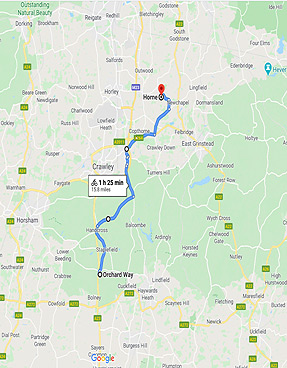
 Please
Click on the thumbnail photos to see the FULL SIZE picture Please
Click on the thumbnail photos to see the FULL SIZE picture
Anyway, he got a bit progressively prosperously rotund and like the Chairman,
was not particularly put out by it, However, in the middle of the Coronavirus
Pandemic he suddenly turned up at Church Farm fully done up in lycra and kitted
out with drink bottles and energy pills, all as a proper cyclist. As the SVVS
Event Pages were dealing with cycling themes, the Chairman asked Stephen what this
was all about? This article was his reply: "Departed Lyme
Cottage 0930 for Horne village, a journey undertaken many times in the past, but
not on two wheels and not in full MAMIL gear, closer actually to OAMIL but
who’s counting! After 16 miles via Handcross and Copthorne I arrived at Church
Farm 11.00 to visit Mr and Mrs SVVS Chairman, our oldest friends by a long way.
To understand how this cycling transformation came about, we have to go back a
year or so to when my weight was about three stone heavier and exercise
comprised little more than the occasional round of golf and countryside walks.
With encouragement from a regular cyclist and member of Horsham Cycling Club who
was doing some work for my company, I was persuaded to take some drastic action
over my general health, but warned that I would have to take my conversion
seriously and see some real benefits, the solution would be not be cheap,
include attention to diet, regular training, and re-learning how to ride a
machine a far cry from the old Sturmey Archer 3 gear Raleigh of my youth! On the
plus side joining a club would mean regular group rides, lots of advice, and
stimulating views of the countryside along quiet back lanes in Sussex and Surrey
more frequented by horses than vehicles.
 
 Please
Click on the thumbnail photos to see the FULL SIZE picture Please
Click on the thumbnail photos to see the FULL SIZE picture
So the journey began, hardly unique to mankind but it did involve quite a major
change to my lifestyle. First stop 'Giant' in Shoreham, one of the largest
makers of all types of bike, for a hybrid model, something I could take both on
the road and down bridleways and on mountain bike gravel surfaces. The'Roam'
model at £500 fitted the bill; three front chain rings and nine cogs at the
back, 38mm tyres together with a rack at the back for my weekend paper run to
Cuckfield. The robust construction came at a weight penalty, but the shop
provided a personal ‘bike fit’, adjusting the saddle both vertically and
horizontally for maximum power output.

My first ‘outing’ was on the Downs Link, nearly 40 miles along an old
railway line, from Guildford to the Sussex coast, and chosen for being mainly
flat and accessible via a number of entry points with car parks. I
chose West Grinstead as a starting point as within a few miles and the path
south goes under the A272 just west of Cowfold and wanders down towards Henfield.
 


 Please
Click on the thumbnail photos to see the FULL SIZE picture Please
Click on the thumbnail photos to see the FULL SIZE picture
After a few trial runs I joined one of the cycling club’s weekend rides in
July 2019 and while able to keep up with the Social group speed, quite clearly
there were two things missing, a proper drop handle bar road bike and suitable
clothing.
 
 Please
Click on the thumbnail photos to see the FULL SIZE picture Please
Click on the thumbnail photos to see the FULL SIZE picture
This is where serious expenditure comes into play, bib shorts, tops, specialist
shoes, helmet, gloves, wet weather gear, and the bike itself. It really has to
be carbon fibre for lightness. So I went to specialist bike shop RJ Cycles in
Tenterten and bought another Giant, this time a 'Defy Pro 1', well into four
figures but one I could lift it with two fingers, hydraulic disc brakes, 28 mm
tubeless tyres, and a 11-34 cassette which was a dream to change gear with. The
ride difference was huge, even though I had to change the razor blade profile
saddle for something more comfortable. By difference I mean much harder and
faster, tyres being at 100psi!
 
 Please
Click on the thumbnail photos to see the FULL SIZE picture Please
Click on the thumbnail photos to see the FULL SIZE picture
As 2019 progressed I started regular weekend rides from Horsham with much advice
from cycling companions. The initiation ceremony for most riders new to the
sport are zero speed crashes, ie falling off when stationary but before
unclipping one’s cleats from the pedals. After two of those and much
embarrassment, it’s been OK since. Rides generally are around the Horsham
district, but I’ve managed to scale Box Hill once but not Ditchling Beacon
yet.
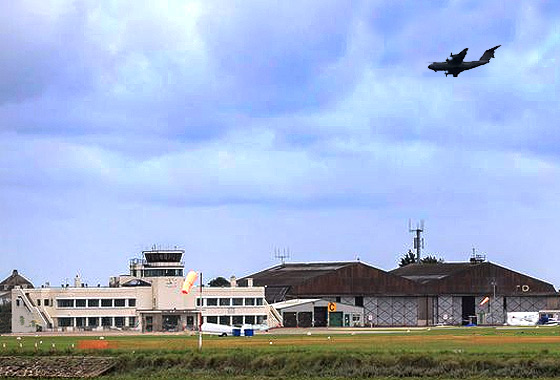
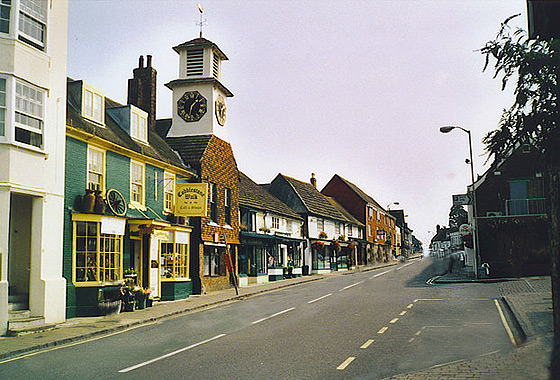
Rides to Shoreham airport (40 miles round trip)
Steyning, Hurstpierpoint, and Partridge Green, all feature regularly and
it’s good to ride most of the time on back roads that are sometimes little
more than farm tracks.
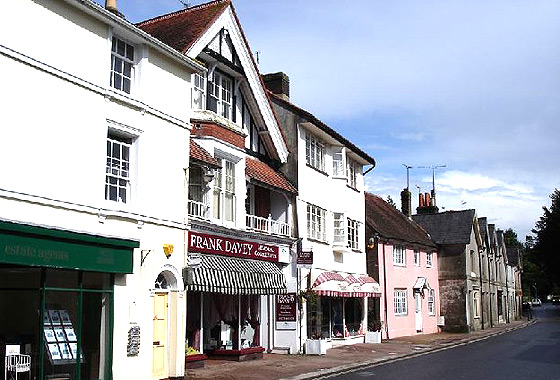

I’ve managed two 50 mile trips and one of them at 14.5 average mph, but the
really sporting guys in the club are doing 18-20 mph, not surprising since
they’re half my age, half my weight and twice my power! My next target is 100,
probably around The New Forest as a little flatter. Whatever tweaks you do to
the bike they’re minor compared with the benefits of weight loss. Three stone
lost in five months, but a few excess ‘lock down pounds’ now have to be
removed. Maintenance is important on what is a highly engineered machine but
washing, degreasing, oiling, and tyre inflation takes care of most of the
regular activity
.
In summary, like most things, you get out what you put in
and cycling is certainly capable of providing an interest of every level from a
short shopping run all the way to the ‘Tour de France’ professionals. The
only advice I would give is set some goals, however simple, and do start a lot
younger than me. The benefits are new sights, new sounds, new friends, and above
all a longer life. It sometimes means even
getting dirty!
 Stephen
Laing Stephen
Laing
 Cycling
the Mini-Motor way Cycling
the Mini-Motor way
On a lazier more laid-back theme, on previous pages the Chairman/Webmaster
Bozi Mohacek has looked at the
French VelosoleX and the Velo-Vap (berlow left) motorised bicycles much favored
by the eight million French users who had the benefit of an enlightened
government who took away most of the obstacles to the public's use of
the machines: minimum age 14, basic insurance, no driving licence, no driving
test, no road tax and no registration number, no helmet and no safety clothing.
It all started in June 1940 when France was overrun by Germany which resulted in
a general fuel crisis to which the Solex Company's answer was to accelerate
developing an economical micro capacity engine to run on a bicycle. The rest is
history. So what did the Brits have at the same time? Lots of rules and
regulations, and the Mini-Motor.
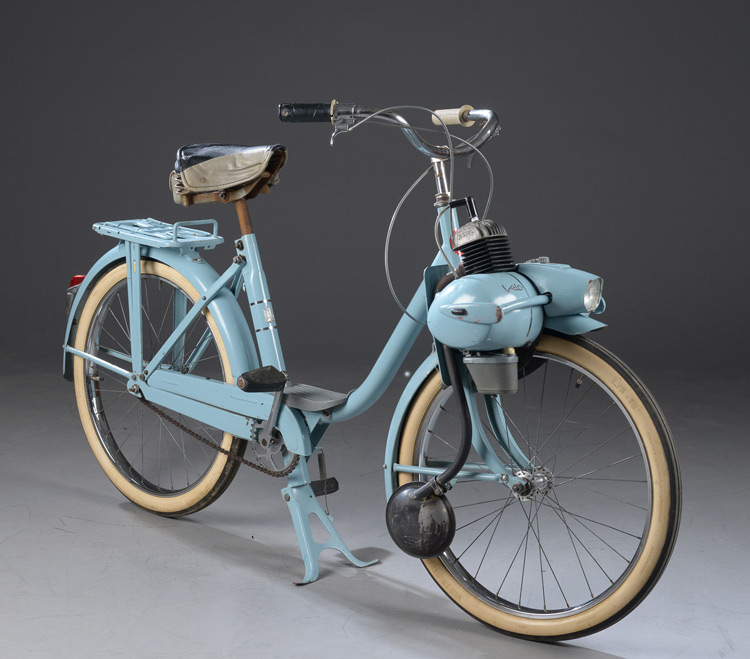

 Please
Click on the thumbnail photos to see bigger picture Please
Click on the thumbnail photos to see bigger picture
In Italy, engineer Vincenti Piatti was equally suffering from post-war lack of
fuel to drive many of the machinery he needed for 1946 daily life so designed a
small 50cc engine that could be used to power portable lathes, which led to
development of the engine for other stationary implements and subsequently led
to the development of an engine that could be attached to a standard bicycle.
This he called the 'Mini Mottore'. He also went on to develop a folding scooter
using the Mini Motor for driving the rear wheel, and later went on to develop
the Piatti scooter in 1954 in competition with Vespa etc.
He obviously had contacts in the United Kingdom because in 1949 The Mini-Motor
began to be manufactured under licence in Croydon by " The Mini Motor (GB)
Ltd.", in Trojan Way, and became known as the 'Trojan Mini-Motor' (above
right). This was a totally self-contained clip-on engine fitted to any
standard bicycle frame behind the saddle and above the rear wheel, - and was
often referred to as an "outboard motor for the bicycle".
Indeed, the Mini Motor was also made as an outboard engine for boats and was
also an add on to the push type domestic lawn mower to provide power assistance.
 
Most of you will know of the Trojan Utility Car if only because our past
President had one. Trojan made impossibly engineered cars from 1914 to WW2. They
also made vans on the same chassis, including the Brook Bond motorised tea caddy
vans. During the seven years of agreement with Leyland to make these in their
Kingston factory, 11,000 cars and 6700 vans had been made. During the war Trojan
made bomb racks, parachute units and aircraft components. Most people probably
also know that post WW2 Trojan made the famous Brook Bond delivery vans and a
range of other commercial vehicles on the same chassis. They also made under
licence the Heinkel bubble car (below left) and sold them between 1960-1966 as
the Trojan 200. In 1962 they started making the Elva Courier sports car (below
right) and later McLaren-Elva racing car.
 
In 1959 Trojan was taken over by the Lambretta Concessionaires, having been
making the Trojan Trobike (below left), a miniature portable scooter based on
the wartime Welbike designed to be used by the Special Operations Executive (SOE).
About 4,000 Welbikes were made during the war. After the war this was further
developed and sold by the Corgi Motorcycle Co. as the Corgi 98cc. The Trobike
was made in smaller quantity, perhaps only 600 or so.  Please
Click on the thumbnail photos to see bigger picture Please
Click on the thumbnail photos to see bigger picture


Lambretta Concessionaires were part of the American group owned by the Clinton
Engine Corporation. Via their range of lawnmowers and chainsaws, Trojan began
involvement in the craze sweeping teenage America – karting (or go-karting).
In 1959 Trojan were manufacturing the TroKart (above right) powered by a 2.5 hp
95 cc Clinton engine; 10,000 engines were eventually made in the UK for use in
karting.
As mentioned previously, The Mini-Motor began to be manufactured under licence
in United Kingdom in 1949 by Trojan in Trojan Way in Croydon. It has been
described by an owner of one of the earlier models saying: "The beauty of
the Mini-Motor lies in its simplicity. The small two-stroke cylinder is hung
beneath the petrol tank, with one end of the crankshaft driving the magneto and
the other end having a serrated drive roller which presses down on the rear tyre.
There is no clutch but a handlebar lever operates a cable mechanism which raises
or lowers the engine onto the tyre. A small carburetor regulates the petrol flow
via a handlebar control." The MK 1 Mini-Motor appeared in UK in 1949, while
the production of the Italian machine continued. The two machines looked very
similar. A separate version was being built in France which had a different type
of petrol tank. In addition there were at least 12 other competitors offering
similar products.


 Please
Click on the thumbnail photos to see bigger picture Please
Click on the thumbnail photos to see bigger picture
There were eventually five variations of the Mini-Motor during the production
run between 1949 and 1957, but the basic principle remained the same. The
'chassis' of the unit was the petrol tank which was hinged off a bar clamped to
the seat pillar. The rear of the tank was attached via a lowering mechanism to a
sturdy hoop fitted over the rear wheel and secured to the bike via the rear
wheel spindle nuts. The mechanism would raise and lower the whole unit pressing
the driving friction roller onto the tyre. The roller went through a number of
evolutions including straight and curved surface, and a grit covered roller with
better grip but which wore the tyre. The roller was also important in starting
the engine as this could slip while the bike was being pedaled off to start the
engine. A decompressor was fitted to help with this problem. The handlebar
controls were a combined throttle/decompression lever, and transmission
engagement lever. Mounting to the cycle frame and tank variations also
followed. The two-stroke engine was 49.9cc and was capable of propelling the
bicycle along at up to 30mph, which is quite fast enough for a pushbike! Petrol
consumption was about 150mpg (some claims said 35mph at 300mpg?) and the
cost was £21. Apparently about a 100,000 were made. Normal standard colour was
blue and some black.
 
The standard Mini-Motor was 50cc but for applications requiring more power a
75cc engine was built and used on delivery tricycles, grocer's bikes and
two-seater tandems. Please
Click on the thumbnail photos to see bigger picture Please
Click on the thumbnail photos to see bigger picture
 
Sturmey-Archer name was also credited with the 49cc two-stroke engine fitted to
early Raleigh mopeds, although this was actually a reworking of Vincenti
Piatti's "Trojan Mini-Motor" and built by BSA's motorcycle operation.
Our friend Vincenti Piatti, who invented the Mini-Motor, went on to have another
venture in scooters that started in Belgium by D'Ieteren in 1954, and
separately in Britain in 1956 by Cyclemaster where they built over 14,000
British Piattis. Cyclemaster ?? Did they not build
bolt-on engines for bicycles?!
 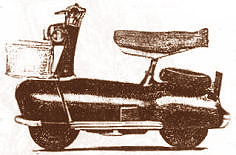
Go to Recent Venues
Page
PICTURE GALLERY INDEX
|




























